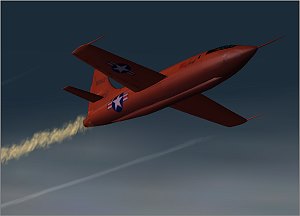  |
|
|
 |
|
BELL X-1
CFS2 / FS2004/
FS2002
- 5 texture sets
-detailed virtual cockpit clickable and with
animations
- specular reflectivity (dinamic shine)
- 2D panel with gauges
- 2D panel pop-ups for radio, engine
controls and brakes
- Canopy animation
- Multiresolution
- landing light
- Shock absorber movement
- Wheel rotation
News pack with
photos and documents about chuck yeager and
bell x-1. | |

  |
|
|
 |
|
Air-launched at an
altitude of 7,000 meters (23,000 feet) from the
bomb bay of a Boeing B-29, the X-1 used its
rocket engine to climb to its test altitude. It
flew a total of 78 times, and on March 26, 1948,
with Yeager at the controls, it attained a speed
of 1,540 kilometers (957 miles) per hour, Mach
1.45, at an altitude of 21,900 meters (71,900
feet). This was the highest velocity and
altitude reached by a manned airplane up to that
time. | |

|
|
  |
|
|
 |
|
Specifications:
Power Plant: Reaction Motors 6,000-lb.
thrust, four-chambered, liquid-fueled (LOX and
alcohol) rocket engine with a burning time of
150 seconds.
Dimensions: Length 31'; height 8' 2 1/2";
wing span 28'
Top Speed: 967 m.p.h.
Maximum Altitude: 73,000 ft.
| | |
